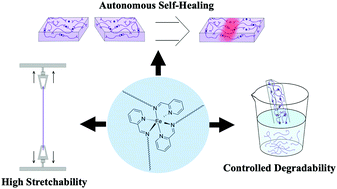Imine and metal–ligand dynamic bonds in soft polymers for autonomous self-healing capacitive-based pressure sensors†
Abstract
In this work, a facile and simple yet effective method to generate intrinsic autonomous self-healing polymers was developed, leading to new materials that can be easily fine-tuned both mechanically and chemically. The new materials were designed to incorporate two dynamic and reversible types of chemical bonds, namely dynamic imine and metal-coordinating bonds, to enable autonomous self-healing, controlled degradability and ultra-high tunable stretchability (up to 800% strain) based on the ratio of metal to ligand incorporated. Through an easy condensation reaction, imine bonds are generated at the end-termini of a short siloxane chain. The new dynamic system was characterized by a variety of techniques, including tensile-pull strain testing, atomic force microscopy and UV-Vis spectroscopy, which showed that the highly dynamic imine bonds, combined with coordination with Fe2+ ions, allow for the material to regenerate 88% of its mechanical strength after physical damage. The materials were also controlled to be degraded in mild acidic conditions. Lastly, application in self-healable electronics was demonstrated through the fabrication of a capacitive-based pressure sensor, which shows good sensitivity and dynamic response (∼0.33 kPa−1) before and after healing.



 Please wait while we load your content...
Please wait while we load your content...